John Quincy Adams Worksheets
Do you want to save dozens of hours in time? Get your evenings and weekends back? Be able to teach about John Quincy Adams to your students?
Our worksheet bundle includes a fact file and printable worksheets and student activities. Perfect for both the classroom and homeschooling!
Resource Examples
Click any of the example images below to view a larger version.
Fact File
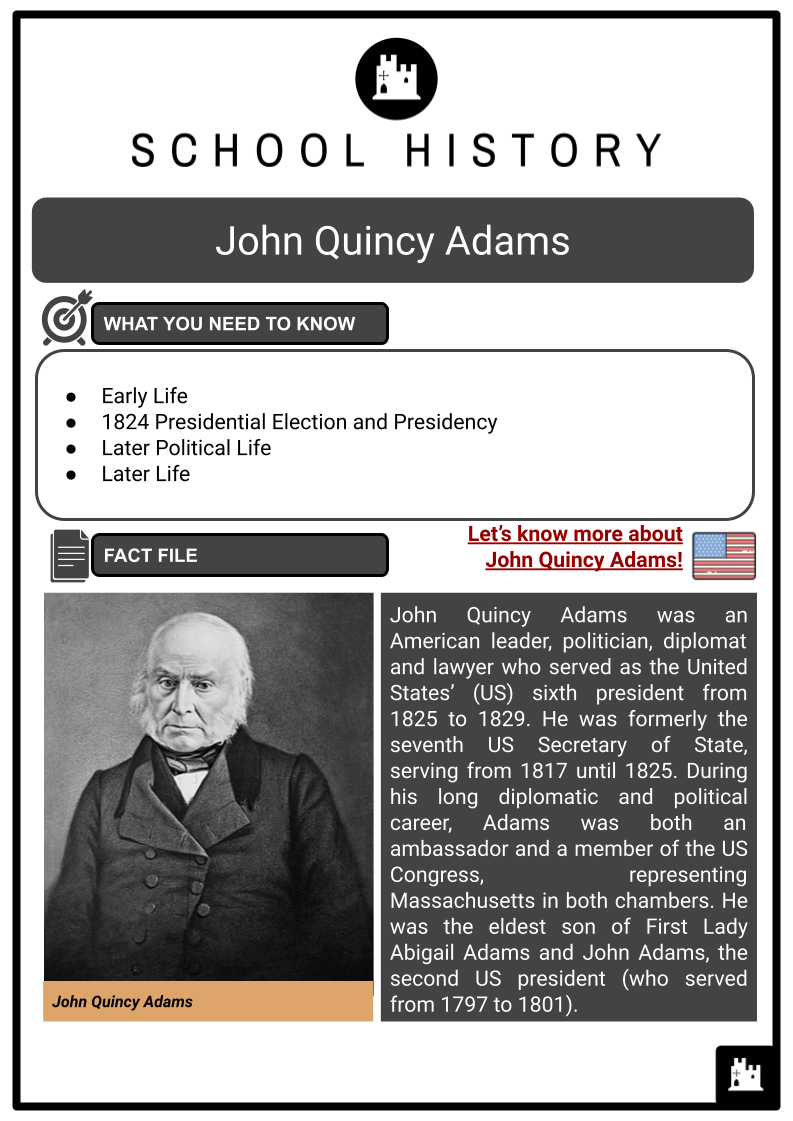
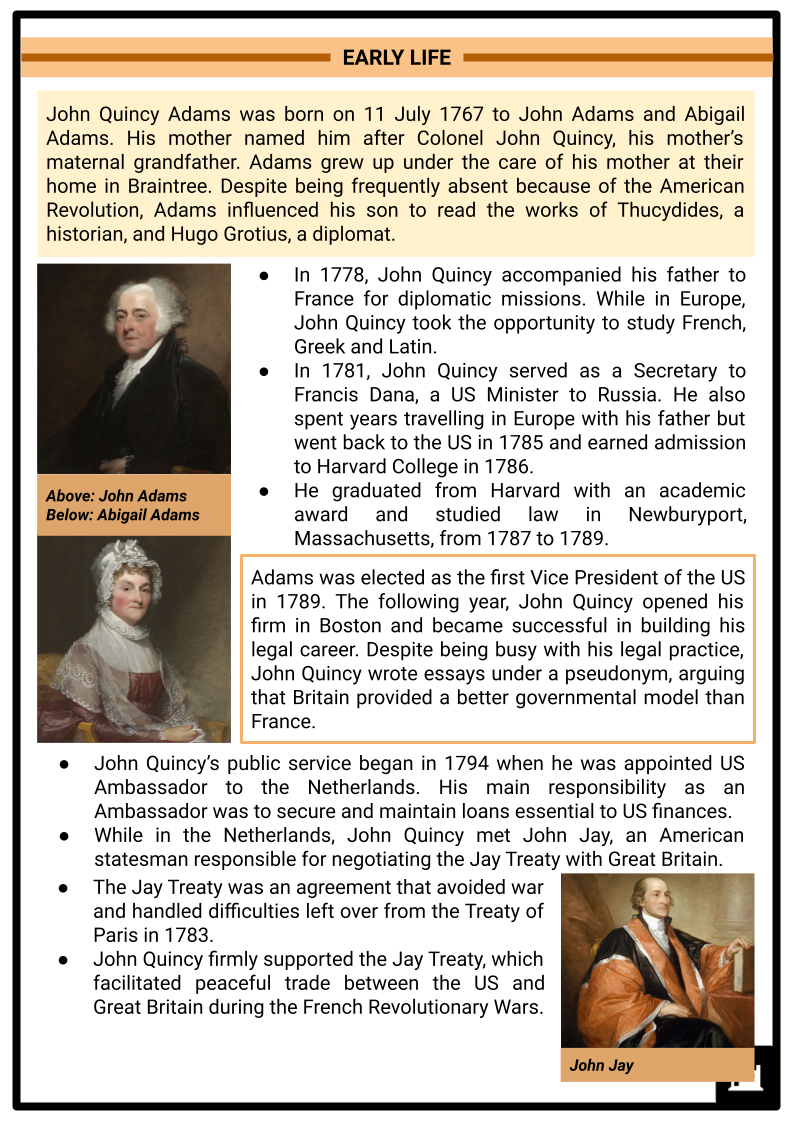
Student Activities
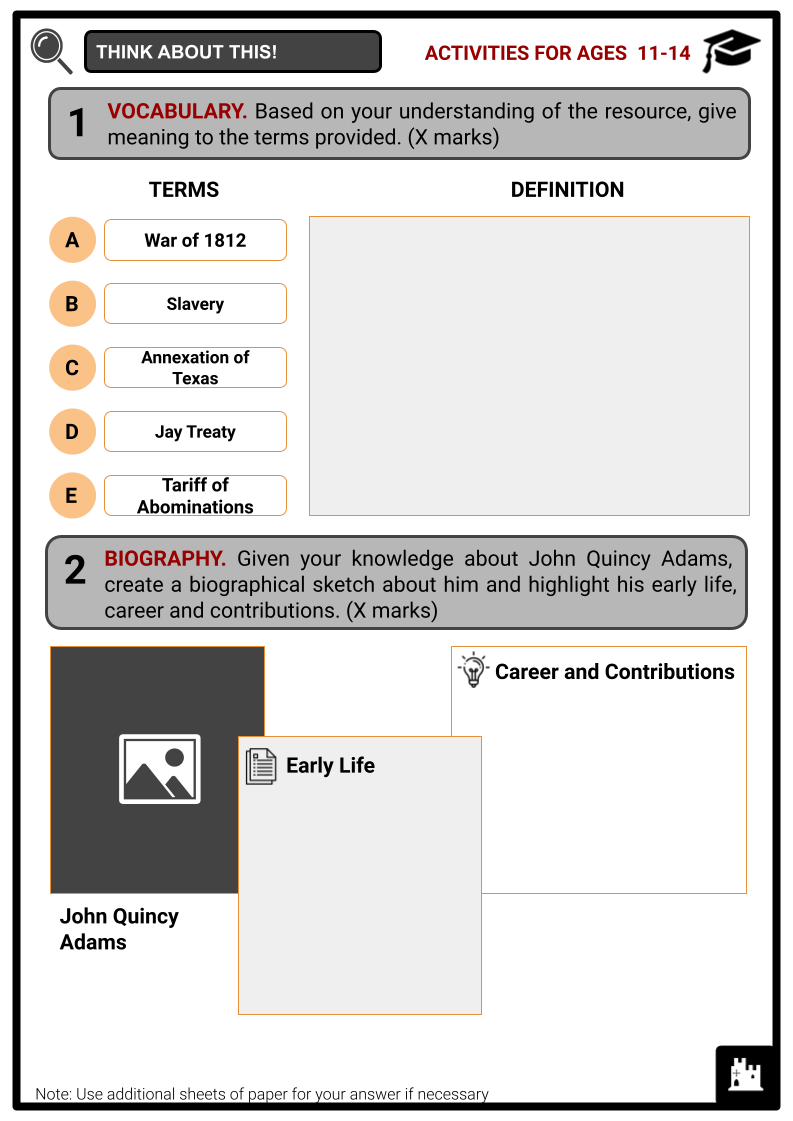
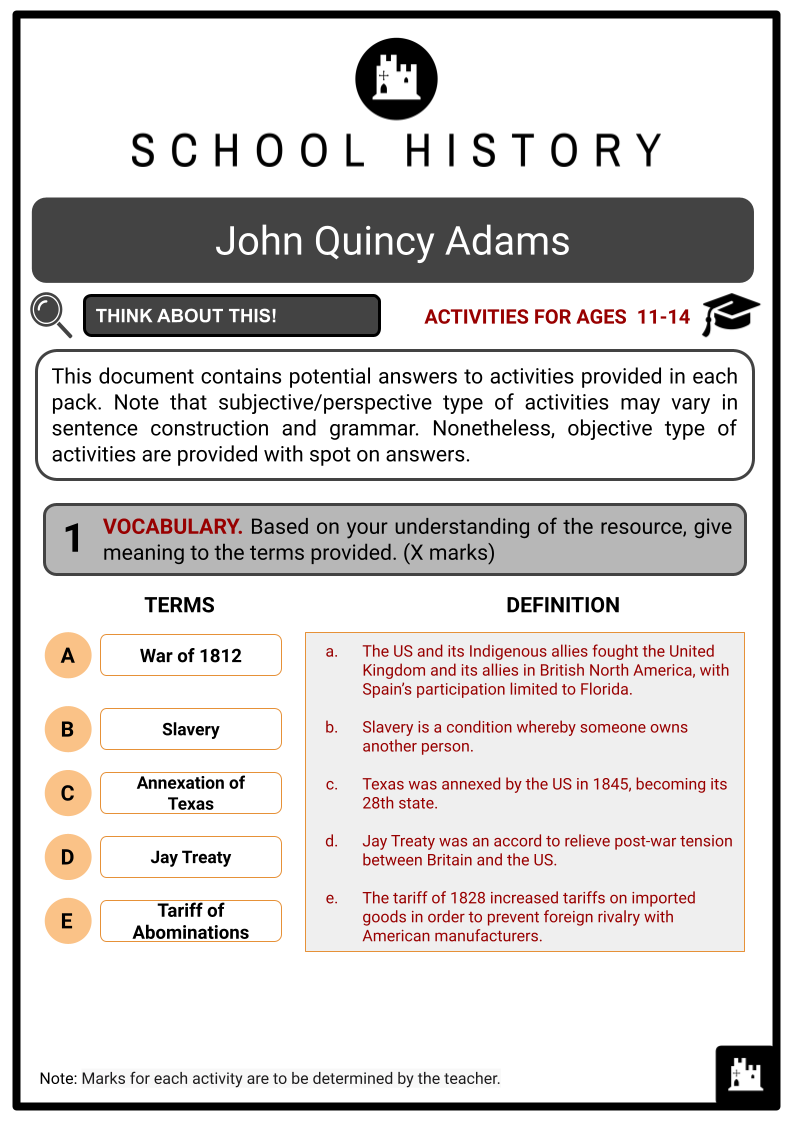
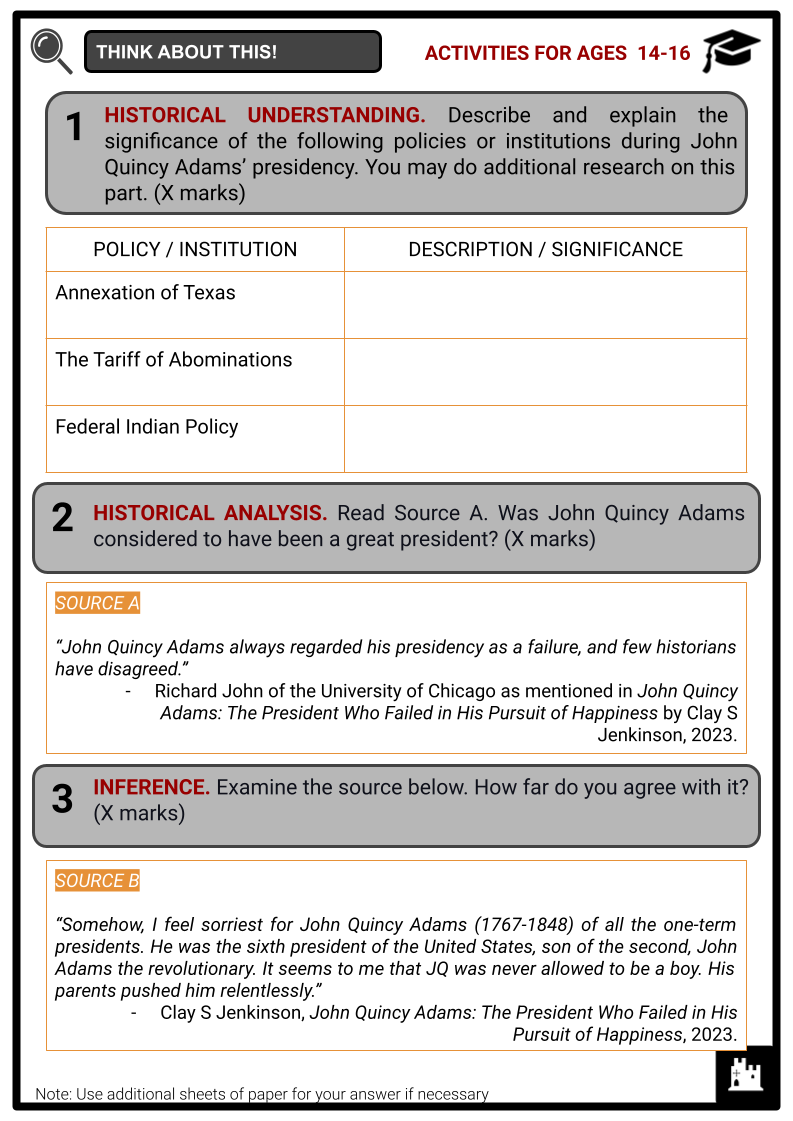
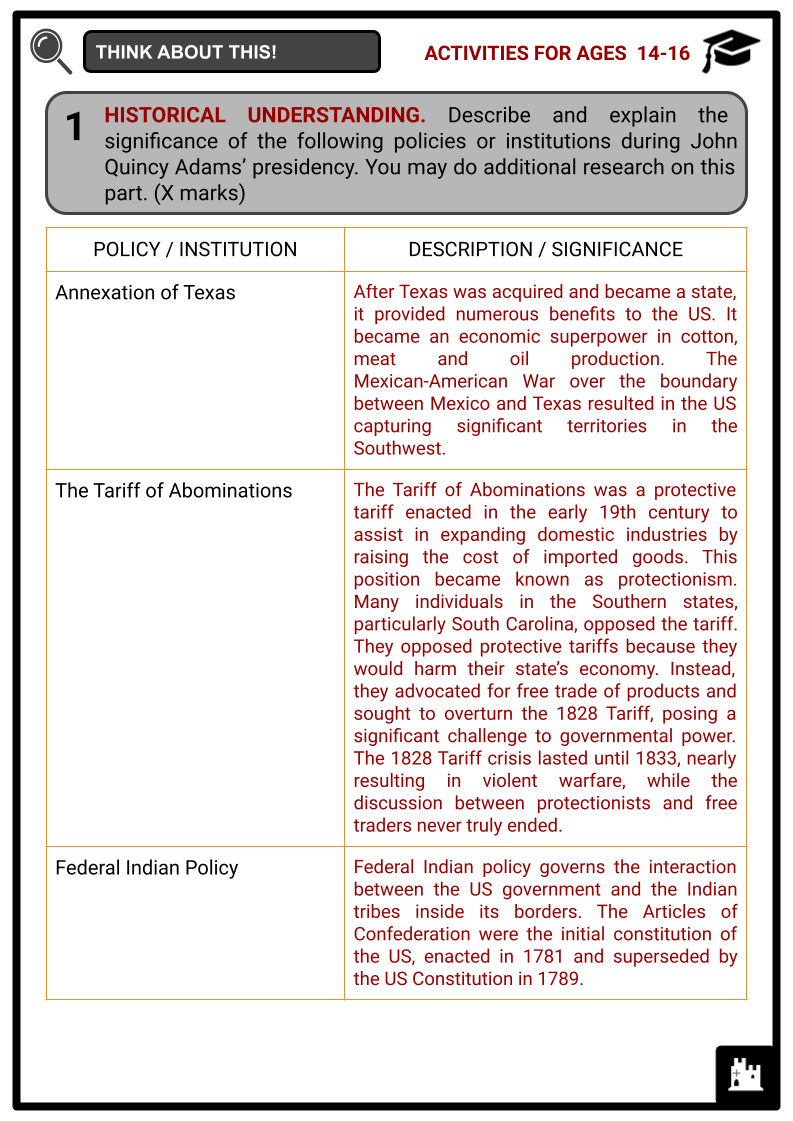
Summary
- Early Life
- 1824 Presidential Election and Presidency
- Later Political Life
- Later Life
Key Facts And Information
Let’s know more about John Quincy Adams!
John Quincy Adams was an American leader, politician, diplomat and lawyer who served as the United States’ (US) sixth president from 1825 to 1829. He was formerly the seventh US Secretary of State, serving from 1817 until 1825. During his long diplomatic and political career, Adams was both an ambassador and a member of the US Congress, representing Massachusetts in both chambers. He was the eldest son of First Lady Abigail Adams and John Adams, the second US president (who served from 1797 to 1801).
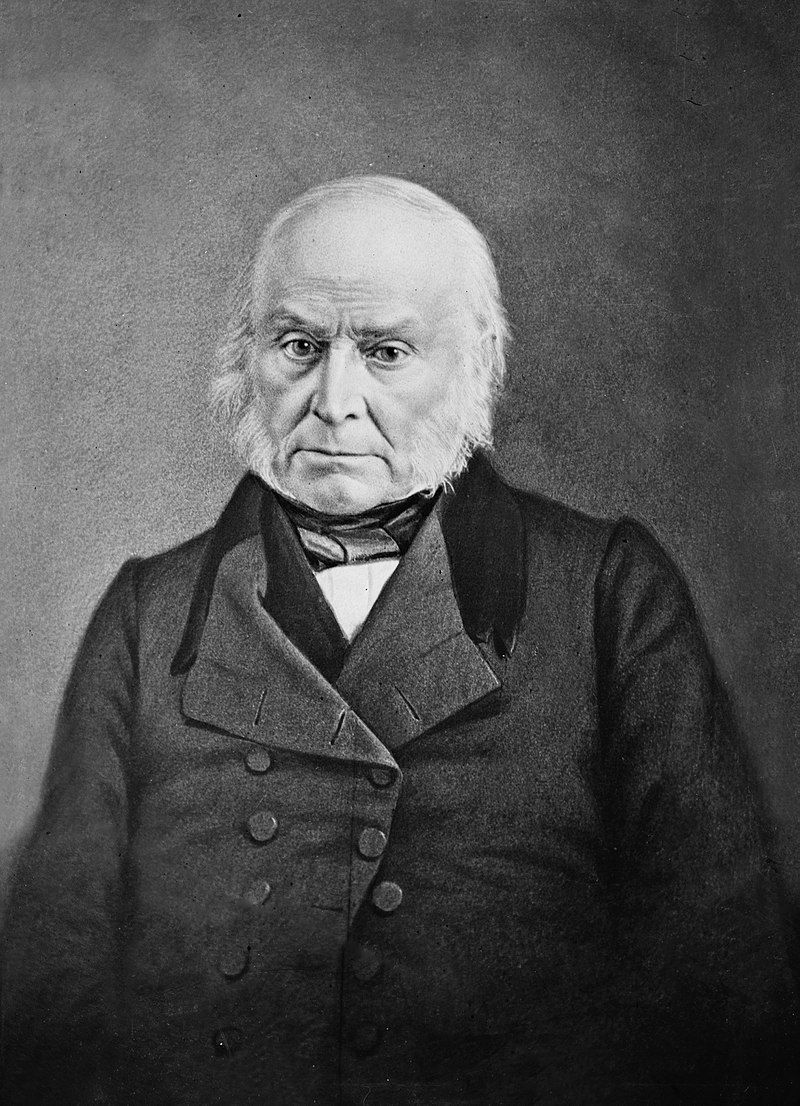
EARLY LIFE
- John Quincy Adams was born on 11 July 1767 to John Adams and Abigail Adams. His mother named him after Colonel John Quincy, his mother’s maternal grandfather. Adams grew up under the care of his mother at their home in Braintree. Despite being frequently absent because of the American Revolution, Adams influenced his son to read the works of Thucydides, a historian, and Hugo Grotius, a diplomat.
- In 1778, John Quincy accompanied his father to France for diplomatic missions. While in Europe, John Quincy took the opportunity to study French, Greek and Latin.
- In 1781, John Quincy served as a Secretary to Francis Dana, a US Minister to Russia. He also spent years travelling in Europe with his father but went back to the US in 1785 and earned admission to Harvard College in 1786.
- He graduated from Harvard with an academic award and studied law in Newburyport, Massachusetts, from 1787 to 1789.
- Adams was elected as the first Vice President of the US in 1789. The following year, John Quincy opened his firm in Boston and became successful in building his legal career. Despite being busy with his legal practice, John Quincy wrote essays under a pseudonym, arguing that Britain provided a better governmental model than France.
- John Quincy’s public service began in 1794 when he was appointed US Ambassador to the Netherlands. His main responsibility as an Ambassador was to secure and maintain loans essential to US finances.
- While in the Netherlands, John Quincy met John Jay, an American statesman responsible for negotiating the Jay Treaty with Great Britain.
- The Jay Treaty was an agreement that avoided war and handled difficulties left over from the Treaty of Paris in 1783.
- John Quincy firmly supported the Jay Treaty, which facilitated peaceful trade between the US and Great Britain during the French Revolutionary Wars.
- In 1796, US President George Washington appointed John Quincy as the US Ambassador to Portugal. Adams defeated Thomas Jefferson in the 1796 presidential election a year later. When Adams became the US president, he appointed John Quincy as the US Ambassador to Prussia. John Quincy served numerous diplomatic appointments after 1794. He and his father left office when Jefferson won the 1800 presidential election.
- After leaving office, John Quincy re-established a legal practice in Boston. In 1802, he was elected to the Massachusetts Senate. In the same year, he ran for the US House of Representatives but failed to win.
- In 1803, he was elected to the US Senate and joined the Federalist minority in Congress.
- Although he opposed Jefferson’s 1800 presidential candidacy, John Quincy supported his administration’s Louisiana Purchase and expansionist policies.
- After John Quincy backed the Embargo Act of 1807, the Federalist-controlled Massachusetts legislature appointed his replacement before the end of his term, which made John Quincy resign from the Senate shortly after that. After resigning, John Quincy returned to his legal practice.
- In 1809, John Quincy was appointed by US President James Madison as the first US Minister to Russia. Though John Quincy had only recently left the Federalist Party, his support for Jefferson’s foreign policy had won him a favourable reputation with the Madison administration. In 1811, Madison nominated John Quincy to the US Supreme Court as an Associate Justice. The Senate unanimously confirmed the nomination, but John Quincy renounced the position, choosing a career in politics and diplomacy. Therefore, Joseph Story was appointed instead.
- In mid-1812, the US declared war on Britain, which started the War of 1812. Tsar Alexander I of Russia attempted to mediate the conflict between Britain and the US. Madison appointed John Quincy, Secretary of the Treasury Albert Gallatin, and Federalist Senator James A Bayard to a team tasked with negotiating an end to the war.
- The British delegation first viewed the US as a vanquished force, and requested the establishment of an Indian barrier state from American land around the Great Lakes.
- By November 1814, the government of United Kingdom Prime Minister Robert Jenkinson, 2nd Earl of Liverpool, decided to seek an end to hostilities with the US based on status quo ante bellum. Even though returning to the status quo would imply an ongoing British practice of impressment, John Quincy and his colleagues and commissioners had hoped for comparable terms. A peace treaty was concluded on 24 December 1814.
- In May 1815, John Quincy learnt that Madison had nominated him as the US Ambassador to Britain. He worked to secure a limited trade arrangement with Britain. Following the signing of the trade agreement, John Quincy spent much of his time as ambassador assisting stranded American sailors and prisoners of war.
- In 1817, newly elected US President James Monroe appointed John Quincy as the Secretary of State. After being appointed, John Quincy returned to the US after spending years in Europe.
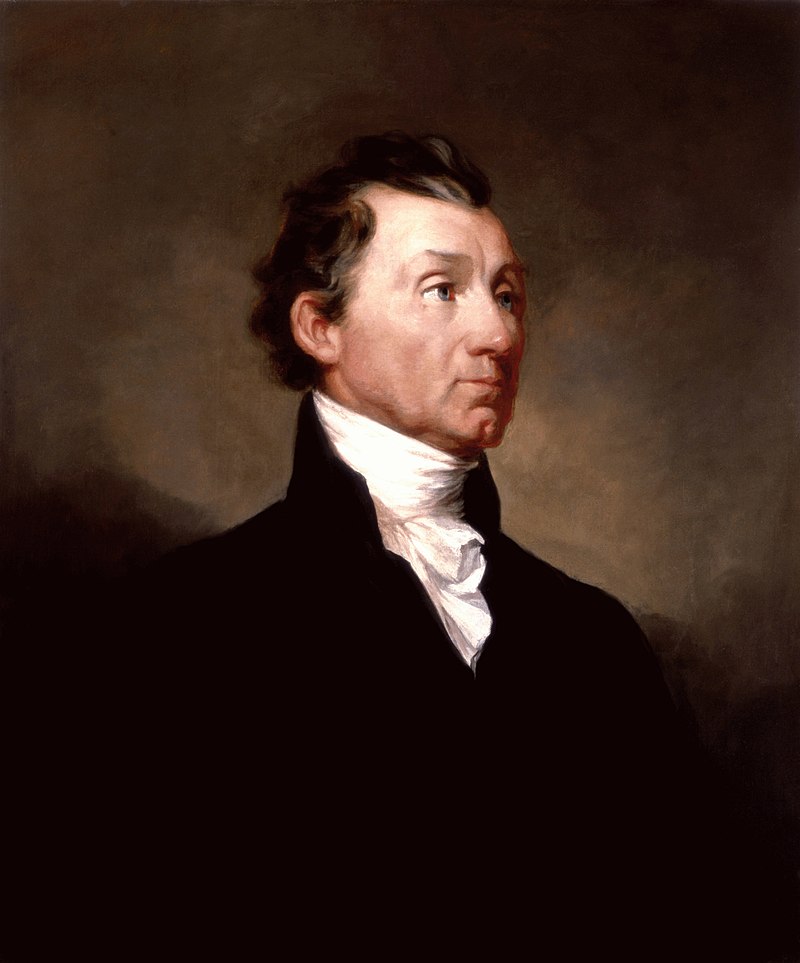
- John Quincy was Secretary of State during Monroe’s eight-year presidency, from 1817 to 1825. Many of his successes as secretary, such as the 1818 convention with the United Kingdom, the Transcontinental Treaty with Spain, and the Monroe Doctrine, resulted from unanticipated circumstances rather than any planning. Aside from the Monroe Doctrine, his final four years as Secretary of State were unsuccessful. He was preoccupied with his presidential campaign and refused to make concessions to other countries that could have weakened his candidature. This resulted in a minor trade war but a successful election to the White House.
1824 PRESIDENTIAL ELECTION & PRESIDENCY
- John Quincy emerged as one of Monroe’s most plausible successors immediately after becoming Secretary of State. As the 1824 election neared, Henry Clay, John C Calhoun (who eventually withdrew from the candidacy) and William H Crawford appeared to be Adams’ chief challengers to succeed Monroe.
- Adams believed his victory as president would vindicate his father, John Adams, while allowing him to pursue a bold domestic programme. Despite lacking the charisma of his rivals, Adams was generally respected and benefited from the absence of other notable Northern political figures.
- With his victory, Adams became the first president’s child to serve as president.
- When Adams became president, he was surrounded by doubters and Jackson’s allies who were determined to make his tenure unpleasant. Adams’ vision for the US was wide and focused on long-term transformation.
- Adams led a productive cabinet, which he met with every week. Adams, like Monroe, sought a geographically balanced cabinet representing the various party factions and asked Monroe’s cabinet members to serve in his administration. Adams’ 1825 annual message to Congress outlined a thorough and ambitious programme.
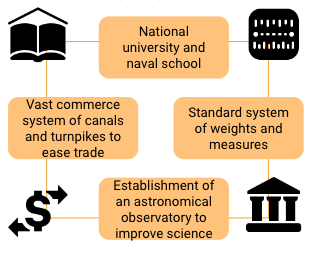
- Adams also advocated the creation of a body of the Interior, a new cabinet-level body to oversee these internal improvements. Adams intended to fund these initiatives mostly through Western land sales rather than higher taxes or state debt. Adams and Clay’s domestic programme, known as the American System, was intended to bring together divergent regional interests to support a strong national economy. Many disagreed with Adams’ vision and programme, believing that authority should be centred on state governments rather than the central government.
- Adams received congressional approval for numerous large infrastructure projects, unlike other elements of his domestic agenda. Between 1824 and 1828, the United States Army Corps of Engineers studied various potential roads, canals, railroads and improvements to river navigation.
- Additionally, the first passenger train in the US, the Baltimore and Ohio train, was built during Adams’ administration.
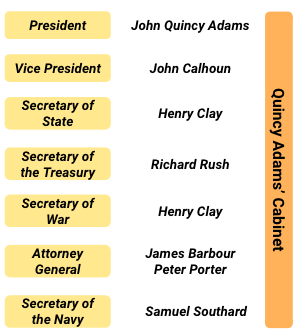
Tariff of 1828
- Outraged Southerners named the 1828 tariff the Tariff of Abominations. Residents in the South claimed that the import tax was exorbitant and unfairly targeted their section of the country.
- The Tariff of 1828 was one of several protective tariffs enacted in America. Following the War of 1812, when English manufacturers began flooding the American market with low-cost items that undercut and threatened burgeoning American industry, the Congress responded by imposing a tariff in 1816.
- The 1828 tariff was implemented as part of a complex political scheme intended to produce issues for Adams. Andrew Jackson’s supporters despised Adams after he won the election in 1824.
- The Jackson administration drafted legislation with extremely high tariffs on imports required by the North and South, assuming the law would not pass. The president was expected to be blamed for the tariff bill’s failure to pass. Moreover, this would cost him support in the Northeast.
- The strategy backfired when Congress passed the tariff bill on 11 May 1828. Adams signed it into law. Adams supported the tariff and signed it despite knowing it would cost him politically in the forthcoming 1828 election.
Federal Indian Policy
- The Federal Indian Policy established the relationship between the US government and the Indigenous Nations within its territories.
- The Nonintercourse Act of 1790 signalled the start of the trade and industrial age. This Act specified that no sales of Indian lands may be undertaken between individuals or states unless the US government authorised the sale.
- Adams aimed for the gradual assimilation of Indigenous people by consensual agreements, a goal embraced by few whites in the 1820s. Adams, however, was firmly committed to the US’ westward expansion.
- Early in his presidency, Adams suspended the Treaty of Indian Springs after learning that Georgia Governor George Troup had imposed it on the Muscogees. The Muscogee and the US signed the First Treaty of Indian Springs in 1821, ceding their territory east of the Flint River to Georgia. In exchange, the US government paid them $200,000 and took over their debts to the Georgian people.
1828 PRESIDENTIAL ELECTION & PRESIDENCY
- The 1828 presidential election was a rerun of the 1824 election, with Adams of the National Republican Party against Jackson of the Democratic Party. Both political parties were new and this was the first time their nominees ran for president.
- Following the 1824 victory, Jackson’s allies immediately began planning a campaign for 1828, and the Democratic-Republican Party split into the National Republican Party and the Democratic Party under Adams’ presidency. The 1828 campaign was characterised by a great deal of negative campaigning, with both parties attacking the personal attributes of the rival party’s candidate. Jackson ruled the South and West, partly helped by the passing of the Tariff of 1828.
- Jackson won the election with 55.5% of the popular vote and 178 electoral votes compared to Adams, who only got 83 electoral votes. The election signalled the start of Jacksonian Democracy. Historians debate the election’s significance, with many claiming that it signalled the birth of modern American politics by removing significant barriers to voter participation and establishing a stable two-party structure.
- By 1828, only two states did not have a popular vote for president, and the 1828 election received three times the amount of votes as the 1824 election.
- The increase in votes was driven by the recent democratisation, greater interest in elections, and the parties’ rising ability to mobilise voters.
- According to an article published on the CNN website by Thomas Balcerski, Adams was absent during Jackson’s inauguration, making him one of only four presidents in history who finished their terms but skipped the inauguration of their successor.
LATER POLITICAL LIFE
- Despite losing his 1828 reelection bid to competitor Jackson, Adams quickly returned to national politics as a Massachusetts’ Plymouth district representative. Adams served in Congress from 1831 until 1848.
- During the latter stages of his administration, US President John Tyler made annexing Texas his top foreign policy objective. In 1844, Adams attempted to ratify an annexation pact, but the Senate rejected it, much to his astonishment and relief.
- Following the election, Tyler, whose term would end in March 1845, proposed an annexation treaty to Congress. Adams fiercely opposed the deal, claiming that annexing Texas would involve the US in a war for slavery. Despite Adams’ objections, both houses of Congress approved the treaty, with most Democrats supporting annexation and most Whigs opposing it.
- In connection with Adams’ opposition to the annexation of Texas, he also opposed slavery. He used his new position in Congress to combat it, becoming the most visible national leader fighting slavery.
- In 1836, partly in reaction to Adams’ continuous presenting of citizen petitions urging the abolition of slavery in the District of Columbia, the US House of Representatives enacted a gag order, requiring that any petitions addressing slavery be tabled immediately. Democrats and Southern Whigs supported the rule, while Northern Whigs, including Adams, opposed it.
- In late 1836, Adams launched a campaign mocking enslavers and the gag rule. He repeatedly attempted to bring anti-slavery petitions, sometimes in ways that elicited heated reactions from Southern representatives.
- Though the gag rule remained in effect, the debate sparked by his activities and others’ attempts to silence him addressed issues concerning the right to petition, the right to legislative debate, and the morality of slavery. Adams vigorously opposed the gag rule for another seven years, eventually introducing the resolution that resulted in its removal in 1844.
LATER LIFE
- In 1846, Adams had a stroke that left him partially paralysed. After a few months of rest, he fully recovered and returned to his duties in Congress. On 21 February 1848, Adams collapsed, having suffered a massive cerebral haemorrhage.
- On 23 February 1848, he died at 7.20pm with his wife by his side in the Speaker’s Room of the Capitol Building in Washington, DC. Their sole living child, Charles Francis, did not arrive in time to see him alive.
- His initial interment was temporary in the public vault in the Congressional Cemetery in Washington, DC. He was later placed in Hancock Cemetery, a family burial spot in Quincy, Massachusetts, across from the United First Parish Church.
Frequently Asked Questions
- Who was John Quincy Adams?
John Quincy Adams was the 6th President of the United States, serving from 1825 to 1829. He was the son of the second U.S. President, John Adams.
- What were John Quincy Adams' major accomplishments as President?
Adams advocated for internal improvements, including roads and canals, and promoted a national university and an astronomical observatory. He also negotiated the Adams-Onís Treaty, which settled border issues between the United States and Spain.
- What is the Corrupt Bargain?
The Corrupt Bargain refers to the accusations against Adams regarding his alleged political deal with Henry Clay to secure the presidency. Clay, as the Speaker of the House, used his influence to support Adams in the House of Representatives.
